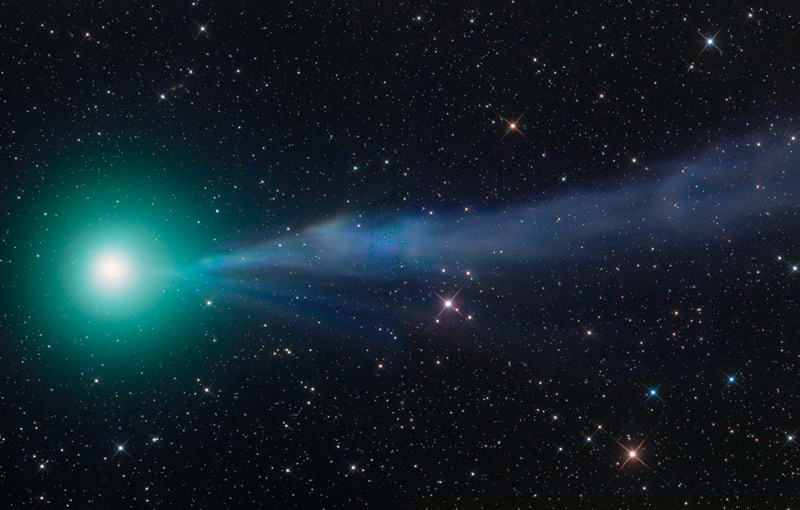This month, Mars remains in the southwest at dusk this month as it moves through Aquarius. Mars continues to fade a little each night as Earth continues to leave it farther behind.
Jupiter is now up most of the night. It rises now at about 8:25, and by January 31 it will rise in evening twilight. Jupiter outshines all stars we ever see at night, so it will be obvious once it rises.
Venus has emerged from the Sun’s glare, and is low in the southwest at dusk. Look for Venus to appear higher in the evening sky in the weeks to come.
Mercury is to the lower right of Venus in the southwest at dusk, but only for a little while. The two are less than one degree apart January 8-12 (Venus is much brighter). After mid-month, we’ll see it head back towards the Sun and drop out of view.
Saturn is in the southeast at dawn.
In January, the Big Dipper only partly risen at dusk. As the Big Dipper rises, though, Cassiopeia remains high. This is a pattern of five stars in a distinct W (or M) shape which lies directly across the North Star from the Big Dipper. Look for Cassiopeia high in the north on fall and winter evenings.
Watch for the Great Square of Pegasus in the west at dusk. Taurus, the Bull is high in the south. Look for the Pleiades star cluster above reddish Aldebaran. Dazzling Orion, the Hunter takes center stage on winter evenings. Surrounding Orion are the brilliant stars of winter. Orion’s belt points down to Sirius, the Dog Star, which outshines all other stars we ever see at night. The Little Dog Star, Procyon, rises with Sirius and is level with Orion’s shoulder as they swing towards the south. To the upper left of Orion’s shoulder is Gemini, the Twins.
Also this month: Look for comet Lovejoy!
Discovered in August 2014, Lovejoy now passes close enough to Earth for us to see. On January 7, the comet makes its closest approach to Earth — about 0.47 AU (a little less than half the Earth-Sun distance. However, Lovejoy is still falling in towards the Sun as it passes Earth; perihelion isn’t until January 30. As a result, it should continue to brighten slightly even after the 7th as it gives off more gas and dust during its approach to the Sun.
Here is Sky and Telescope’s Lovejoy finder chart for this month. Note that you’ll find Lovejoy high in the evening sky to the west (right as you face south) of the bright pattern Orion, the Hunter. What’s more, the Moon, now past full, moves out of the picture right as Lovejoy is shifting northward in our sky, thus appearing higher each evening. Thus, if you are able to go far from city lights, you can see Lovejoy dimly with the unaided eye. Observers are reporting a bluish/greenish glow, indicating that Lovejoy is producing little dust and that the gas tail dominates (dust would reflect sunlight, making the comet look whiter).
Our only chance to see this particular comet comes this month; once it’s gone it won’t be back for 8,000 years!
Moon Phases in January 2015:
Full: January 4, 10:53 p.m.
Last Quarter: January 13, 3:46 a.m.
New: January 20, 7:14 a.m.
1st Quarter: January 28, 10:48 p.m.
At 1 a.m. on Sunday, January 4, the Earth came as close to the Sun as it will for the whole year. This was perihelion.
Although the winter solstice is the shortest day, the earliest sunset occurred on about December 2, and the latest sunrise will occur January 10.
That’s because the Earth speeds up on its orbit as it approaches perihelion (closest approach to the Sun). This acceleration shifts sunrise, local noon, and sunset slightly later each day for the first part of this month. The effect is smaller than that of the Sun taking a lower path across the sky, which normally dominates in causing earlier sunsets and later sunrises. But the Sun’s apparent path varies very little near the solstice itself, allowing the secondary effect of the Earth approaching the Sun to predominate until mid-January. Most people, then, will notice that both sunrise and sunset are now happening earlier than in December. As we move farther from the solstice, the effect of the Sun taking a slightly higher path each day again predominates.
Click here for the Burke Baker Planetarium Schedule.
On most clear Saturday nights at the George Observatory, you can hear me do live star tours on the observation deck with a green laser pointer. If you’re there, listen for my announcement.
Clear Skies!



